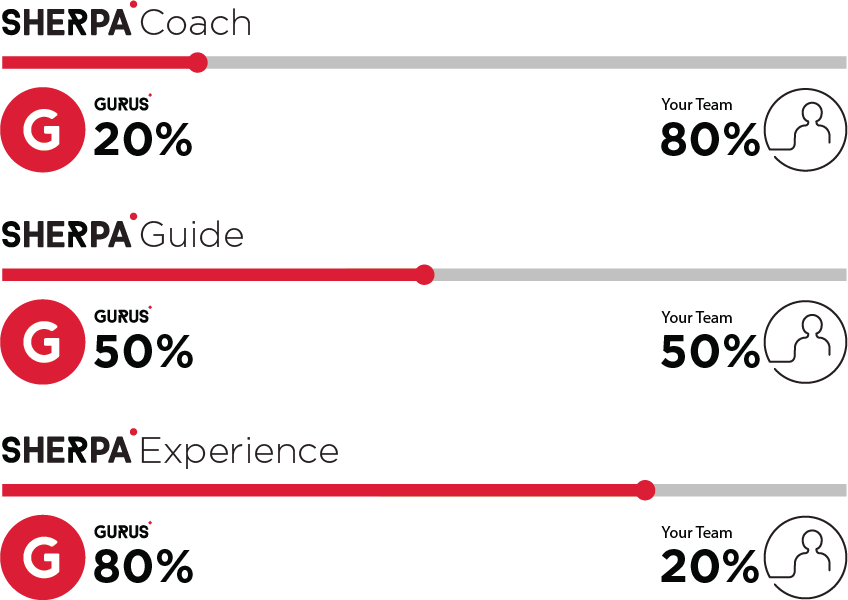So, you’ve decided on upgrading your business to NetSuite.
However, taking on a new Enterprise Resource Planning (ERP) system for your company is a tremendous undertaking, no matter the size of your business.
That’s why our team at GURUS has created this fully comprehensive NetSuite ERP Implementation Guide covering the broad range of critical factors for a successful project. For businesses evaluating ERP systems like NetSuite, our experts provide end-to-end NetSuite ERP implementation to ensure your project is delivered on time and on budget.

The good news is, if you’ve already picked up on the core signs that it might be time to upgrade your outdated systems (whether it be spreadsheets-based like Quickbooks or a legacy solution you took on early on in your company’s growth), you have already taken the first big step.
We can help you with the rest and hopefully answer some of your pressing questions below.
NetSuite ERP is a unique, yet complex software that curates an abundance of specific needs and requirements of an organization. There are customizations, modules, integrations, and configurations that can all be personalized to your own objectives.
Before even thinking about a NetSuite implementation strategy, it’s important to navigate your way through your current processes and operations in order to understand your business goals and objectives.
Once communicated, the process of implementing the software can begin.
The best approach to successfully implementing a NetSuite system is to learn about NetSuite and its different components. Then you can analyze the best practices for you and move forward with the implementation plan.
Not to mention, you need to establish an internal implementation team as well as training for potential NetSuite users.

Be sure to start out with the 3 most important items that will factor into your plan:
![]()
A clearly defined scope of what you want as an implementation is critically important to your process.
It’s very important that you do your due diligence here and set a realistic timeline based on what you want NetSuite to do, how many added features you want, the depth of your data migration (do you have years and years of historical data?) and how many people on your team will be assigned to work with your implementation partner.
![]()
Choose the right players from your internal team to oversee and assist with all necessary steps of your implementation project.
![]()
Most importantly, start setting goals early on.
This will accelerate your implementation process and increase the likelihood of success. Before you start launching anything, sit down with your executive team to explore and agree on short term goals for NetSuite.
Are there immediate pain points you want to address? What long-term priorities do you have?
Your Step-By-Step Implementation Guide
When implementing NetSuite, a general rule of thumb to remember is that no implementation is the same.
That being said, while the below guide is not set in stone, it has aspects that anyone about to start a NetSuite implementation should know.
![]()
Discovery
The very first step of any implementation - this is where all the research and development is done regarding the project.
Goals are established, gaps are identified, and potential requirements for data migration, business processes, and integration systems are discussed.
![]()
Planning
Now that the research and development is out of the way, it’s time to take those discussions and put them into motion.
Internal teams, partners, and external stakeholders will establish a timeline, assign tasks and responsibilities, as well as decide who will be the key members of the implementation process.
![]()
Execution
Say goodbye to the nitty-gritty aspect of a project, it’s now time to get your hands dirty and jump into the NetSuite software.
Key features include: data migration, configurations, setting up accounts, integrating modules, building workflows and integrations, as well as assigning roles and permissions.
![]()
Training
This is by far one of the most important steps in a NetSuite implementation and should not be left by the wayside.
After external resources have moved on, if your internal team is not properly trained on NetSuite they won’t know how to troubleshoot any issues that come up.
Not even that, you won’t have the proper experts to show other users the best ways to utilize NetSuite. Successful implementations stem from training the appropriate team members to continue the process after the go-live.
In order to get proper training, you can go directly to NetSuite or ask your NetSuite implementation partner. There are many workshops, online tutorials, and guides available for NetSuite users.
![]()
Testing
Before the go-live, it’s extremely important to test. This is vital to any software project. During this process, development and external teams ensure all customizations and automations are set up and are working properly.
Users will then have a chance to test the different processes and functions. Remember, training must come before testing, otherwise users won’t know what to look for.
Take your time during the testing step and establish any issues or problems that could be problematic for the go-live. Sometimes this step can take longer than planned, but better to know what to fix beforehand than experience a rushed go-live that can bring companies more than just a stress migraine.
![]()
Go-live
The time has come. Press the big red button that says “launch” and away you go - metaphorically, of course.
Once the other steps have been completed, you’ve thoroughly tested the software, and your NetSuite partner gives you the green light, you are ready to go live.
You can now start using NetSuite and discover all the positive changes it brings to your operations.
![]()
Post-Go-Live
In most cases a go-live runs smoothly, however, when it comes to technology and software unforeseen issues are not impossible.
During this post-go-live time, stay in touch with your NetSuite partner for a few months in case something pops up and you require external help.
In fact, don’t let go of your NetSuite partner any time soon as they will be there for years to come to provide ongoing support and keep you aware of ongoing processes, updates, and upgrades that will be useful to your NetSuite instance as you scale.

One of the most critical steps in your implementation process, and the one where most companies fail, is choosing the right implementation partner to guide the project.
If not done right, or with the right experts, implementing a new software can, more often than not, create challenges that directly affect your business operations. The right implementation partner, on the other hand, can help share lessons learned and experience gained on past implementations to help you avoid expected challenges and overcome significant hurdles you'll be facing along the way.
At this point, some will ask: “Do I really need a NetSuite implementation partner? Can’t I just self-implement a new system?”
The answer isn’t a clear “yes” or “no”. That being said, some companies attempt to implement NetSuite on their own to save money, which, unfortunately, in the long run actually ends up costing them more.
Identifying gaps in operations, data migration, unforeseen issues, training, cost, and time are just a few things that surround a NetSuite implementation. Handling all this internally requires more than a few webinars and demos on implementation processes, it requires a lot of manpower as well as invaluable expertise.
Self-implementation can end up costing a company way more than expected and lead to unnecessary problems without the knowledge to fix them, leading to delays.
Through the NetSuite implementation planning process, a partner has access to NetSuite Consultants, Developers, Project Managers, and of course, decades of experience in all aspects of ERP.
Considering the fact that no technology is perfect and is bound to have hiccups along the way, a partner can ensure speedy recovery.
What is a NetSuite Implementation Partner and What Do They Do?
When it comes to launching a new business software, there is a lot to consider. Not to mention, a lot of information that best describes the various strategies of a successful implementation of an ERP.
This is where a NetSuite implementation partner comes in.
In a nutshell, NetSuite certified partners are companies that sell NetSuite licenses as well as a variety of other technological solutions. As a third-party vendor of NetSuite, they’re located across the world.

Depending on your NetSuite needs, you’ll also be able to find a shop that is not only local to you, but specializes in industry verticals with NetSuite consultants that have decades of experience.
Oftentimes, a NetSuite partner will offer custom solutions, unique third-party partnerships, and integration software.
They’ll take your particular NetSuite instance and guide you through the whole implementation process, all the way to the go-live. Access to project managers, developers, and consultants ensure a successful go-live.
A NetSuite implementation partner will communicate with you to establish your requirements and business goals and whether or not you require a more personalized approach.
Additionally they provide technical and industry expertise that isn’t available online or when within your internal team.
And if there are ever any hiccups along the way, their expertise and knowledge will solve the issue in no time.
It is a tremendous undertaking with a lot of moving parts. When you make an investment like that, you want to be sure that you don’t run into any costly or potentially hazardous issues somewhere down the line.
Who better to help set you up for long-distance growth than folks that have spent their lives with NetSuite, right?
The right implementation partner, who leads through experience and lessons learned, will help navigate the waters and make it easier, faster and safer to get to your desired destination.

How Do I Choose My NetSuite Implementation Partner?
There is no one-size-fits-all category for a NetSuite implementation partner.
A critical factor for a successful NetSuite implementation with a partner is to choose the right experts for your industry, your system, and your priorities. It is important that they have an understanding of your business model, as well as strong chemistry with your internal project team.
Your NetSuite project’s success depends on your implementation partner’s ability to understand your business requirements and set up a strong channel of communication with your key players.
Here are a few key tips and tricks to have in your pocket when hiring a partner:
![]()
Time and experience in NetSuite
The longer they’ve been a NetSuite partner, the more knowledge and experience they’ve gained to become leading partners.
![]()
Specialized Offerings
Are they specialized in NetSuite? Sometimes a one-stop-shop means it’s a generalized firm that attempts to know it all. You’re better off with a company that has specialized in NetSuite with top-level knowledge in customizations for your particular organization.
![]()
Company Values
You’ll be working with your NetSuite partner for a very, very long time. Make sure that they’re a good fit, not only for technical aspects, but cultural as well.
GURUS Solutions provides clients with round-the-clock NetSuite consultants that leverage nearly two decades of experience across several industries in the world of Oracle NetSuite and its ecosystem of third-party applications.
The first thing that you’ll discuss with your implementation partner is a step-by-step strategy and roadmap for what the implementation is going to look like. You want to know exactly what you’re getting into, including:
- NetSuite Implementation Timeline and Cost
- Training Plan
- Risk Assessment
- Obstacles Overview
- Target Outcomes

That way you know what to expect throughout the process. The beginning stages are very important as you want to avoid any unnecessary surprises for your internal stakeholders.
This is a summary of a NetSuite implementation planning guide that provides a short list of the best practices for a successful implementation plan as well as the critical aspects of the planning stage you should address before you start.
While not a complete and inclusive list, it will give you an idea of what to expect. For more information, it’s highly recommended that you contact us.
Once we have an understanding of your real business needs, goals, and future vision, then we can help you build a more specific project plan tailored to your needs and requirements.
Planning Readiness
Create a roadmap to plan out the initial shut-down of legacy systems to transactions being recorded in the new system.
This includes: pen-transaction migrations, opening balances and inventory, as well as the strategy to validate the final import.
Ensure all resources are ready and onboard. Are stakeholders and department leads available? What about consultant resources? What’s the buffer in case of delays? Look at the logistics of external support and stand-by staff for IT, etc.


System Readiness
Begin with a “Conference Room Pilot”, which involves validating the new software in terms of the business processes of the end-users, by allowing them to use it to carry out typical or key business processes.
An ERP is an integrated system that fosters collaboration, and testing cannot be made in silos.
The second step is end-to-end testing to give you an idea of what will work, what won’t work and planning around the go-live phase.
Stress or load testing will help you develop an understanding of the limitations of the software by pushing it to its breaking point. It will help you gauge capacity and measure how it will handle your demands.
Whereas, data readiness involves checking your data to see if the migration will require light touch-ups for messy data, as well as get a good grasp of the mapping.
Finally, equipment readiness means looking at what kind of hardware will be required by the time of the go-live. What is available? What needs to be added? Even SaaS requires some pieces of hardware!
People Readiness
End-user training will help evaluate the extent to which end-users can operate and navigate the system. It will help them get used to the new software and learn some of its best practices. It's also a great way to get them excited about the upgrade!
Launch a post-go-live end-user support plan. This will involve setting up points of contact for end-users needing help or facing issues after the go-live.
You also get access to hands-on and over the shoulder feedback to help ease the transition - as well as access to documentation.


Business Readiness
With new systems comes new processes. The new process awareness stage is where we ensure your team is aware of the changes and how they can best use them to their advantage.
You don’t want any confusion later on, and this is where we help you avoid it.
Something that cannot be stressed enough is having internal department communication. Integrated systems mean new and improved business platforms.
You want your departments aware of the changes, so they can coordinate with each-other. Again, this whole step is about avoiding surprises among your team.
Just like you need internal communication, there is the other end of the stick: external stakeholders communication. How will your new system affect customers, vendors and partners? What are the important factors they should consider about the new system? Everyone likes positive change - but once more, it’s important to be aware of it beforehand.
Risk Contingency and Mitigation Plan Readiness
When it comes to risk and mitigation readiness, there are a few important items to follow:
1. Project Go-Live Risk Management
We look at any potential risks that could potentially derail your go-live. How can we minimize the risks? What is the impact? Here, we talk about contingency plans and ways to mitigate difficulties.
2. Business Go-Live Risk Management
You need a safety belt for your business in case any small detail goes wrong during the go-live. We encourage total readiness, and that means preparing for the worst case scenario - no matter how unlikely it is.

3. Last Minute Cancellation
You have the option of delaying or canceling a go-live at the last-minute. Oftentimes, companies feel a pressure to meet the go-live date planned out at the beginning, but that pressure is not worth the risk of going live if you think there are unforeseen issues that might arise (ex: shipping labels don’t print - preventing shipments).
We strategize and plan for these worse-case scenarios from the start to avoid last minute panic.
4. Post-Go-Live Rollback
In case the go-live phase presents issues, or becomes infeasible due to an unexpected issue like shipping labels not printing or shipments not being able to go out, you can ask for a time assessment of when the issue will be fixed and ask for a rollback.
At this point, you will revert to your legacy system for the time it takes to repair the issue and smooth things out. This is a last resort, but it can be a lifesaver if you’re prepared for it in advance.
What is Data Migration and how does it affect NetSuite Implementations?
Even the most proactive organizations that spend countless hours researching and discussing their implementation will often underestimate the amount of work involved in data migration.
We’re not just talking about migrating historical data, although that alone can tie up a lot of time and resources if you have years of it.
When you’re implementing NetSuite, you should consider beforehand what information in your old systems might be outdated, muddled or obsolete.

You’re about to undertake a massive transition, which is a great reason to clean up your historical records and figure out what you want to carry over. Are all of your contacts, clients and suppliers even still accurate in your lists?
If your company has been around for a decade or longer, then you likely have some clean up to do in advance.
It’s worth parsing through your legacy data here and figuring out what’s become obsolete vs. what is important data that you want carried over.
Data migration, when poorly planned, can significantly delay your go-live and cause obstacles throughout the process and long after. Putting bad data into a new system is like putting old gas into a new car - it will never run like it should.
However, if you plan ahead, a smart data migration can help make your system more efficient and give you cleaner data to start with as you go-live.

The difference between an on-site ERP to a cloud based ERP?
Implementing an on-premise ERP system involves expensive hardware and software components. For this, your initial implementation phase will require delivery and installation.
This will also mean that you need key players with technology skills on your team to help with the installation and configuration, as well as support and maintenance down the line.
With a cloud based ERP, you can skip this whole step as your system will not have a hardware component and will likely be maintained under a SAAS model.
NetSuite is 100% cloud based and automatically updates twice a year to evolve at the pace of technology, with little to no intervention from your staff.
What are the main causes of NetSuite implementation delays?
As a long-time NetSuite implementation partner, the main causes that we have identified for delays and struggles during a project are typically associated with the original planning phase.
Get your plan and structure right before you start an implementation, because course correction becomes much more difficult after a project is underway.
Before you start a project, make sure to have a good understanding of when you want to go live.

You need to be realistic here and even add some flexibility. Trying to take on a large implementation project for your new NetSuite system with a very tight timeline is never a good idea, considering how many moving parts there are at any given time.
Sit down with your implementation partner and discuss the key points, ask them for a realistic timeline and plan contingencies.
Some organizations make the mistake of having only one key player on their side handling their internal team member tasks during their project - and if that person leaves the project for any reason before project completion - that will heavily impact your go-live.
It's critically important to have a strong communication channel with both your partner and internally among your key stakeholders on the project.
How much does a NetSuite implementation cost?
The costs associated with a NetSuite implementation will differ depending on a variety of factors, including:
- The size of your data migration project.
- Whether your system needs to be integrated with other legacy systems in your organization.
- Any system add-ons purchased that will need to be installed before go-live
- Project complexity and additional training and support requirements
- Project timeline
- Unique business needs
For NetSuite ERP implementation costs, you can refer to our NetSuite Pricing Guide.
What is the best approach to NetSuite implementation?
There is no one approach to implementing a NetSuite system, however there are a number of critical success factors to any given project.
NetSuite will integrate crucial functions across your organization, from financial management to sales and marketing, human resources, project management, inventory, warehousing, supply chain management, eCommerce, and the list goes on.
These integrations are customized to your industry, with NetSuite offering an entire ecosystem of supporting applications for your specific requirements.
The implementation of NetSuite is the process that you undertake for scoping and planning, and configuring and deploying your new system to deliver increased productivity and visibility across your organization as it grows.


1. SHERPA Coach
Does your organization have its own internal team of key players in finance and project management with ERP experience and knowledge?
Does your team already have experience implementing legacy systems and want to take control of your NetSuite implementation with an internal project lead?
You can choose our Coach implementation approach, which means that your internal team leads your project, with GURUS as guides and supporting resources to help make sure you quickly overcome any struggles and have a successful go-live.
2. SHERPA Guide
Our SHERPA Guide approach is a 50/50 split when it comes to your NetSuite implementation, meaning our team of consultants collaborate fully with your own internal team.
This is the approach that we generally recommend to our clients, as it combines our years of NetSuite experience with your team’s in-depth knowledge of your current business processes and needs.
This way also ensures that your team is trained and knowledgeable in most things NetSuite by the time we get to go-live, so that they will be familiar with NetSuite and system architecture by the time your transition is complete.
3. SHERPA Experience
SHERPA Experience is our NetSuite guided implementation approach.
It lets your team take it easy, while we deploy our best consultants to deep-drive into your business processes, build in-depth knowledge of your requirements and lead a seamless implementation process all the way to go-live.
This is the ultimate white-glove experience for your NetSuite ERP solution. We recommend this if you don’t have internal resources that you’re ready to allocate to the project and you’re also looking to work with the same NetSuite partner for years to come.
By the time your project is done, our consultants will be intimately familiar with your business, inside and out, and be ready to lend support with ease at any point or build custom scripts when required.
Do you feel ready?
Now that you know what each part of the planning process entails, take the time to explore your overall readiness.
Read these steps and cross-reference with them. Discuss things at length with both your implementation partner and your team.
And as you’re nearing your go-live, if you foresee an issue and you’re thinking of delaying, take the time to make a pros and cons list.
Sit down with your executive board and weigh your risks and rewards. Do the benefits of going live NOW outweigh the benefits of waiting an additional few weeks to polish and mitigate risks?
GURUS Solutions NetSuite Certified Partner
With almost two decades of NetSuite experience under our belt, we’re a leading NetSuite partner in Canada.
We’ve mastered the complexity of NetSuite as well as integrations, customizations, and even our in-house data reporting tools.
If you’re set on NetSuite, but still unsure about implementation partners, give us a call and we’ll see if we’re a good fit.

